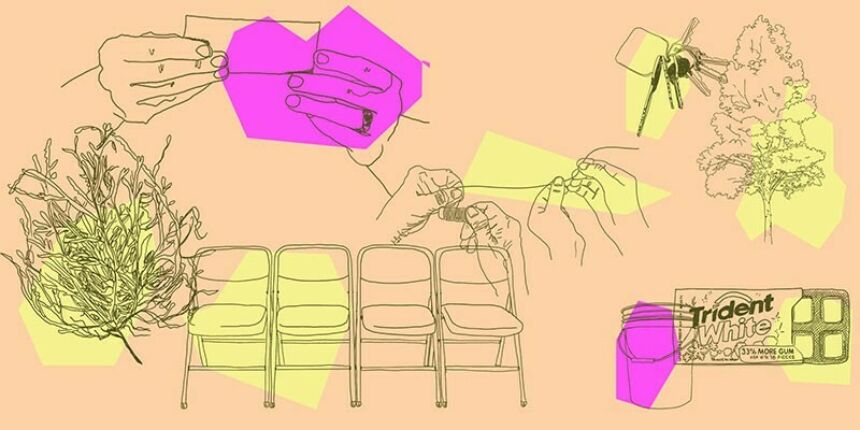September 18, 2023
How 'A Thousand Ways: An Assembly' by 600 Highwaymen becomes a radical act

By Heather Longley
For artist Abigail Browde, theater and “being” in a public space overlap.
“My definition of the theatre is an experience that lasts over time, for an event to be witnessed,” she said. “I think it's an experience of attendance.”
She and her husband Michael Silverstone are the theater-making duo 600 Highwaymen, which explores the power of attendance with the intimate event “A Thousand Ways: An Assembly.”
The unmoderated performance explores the line between strangeness and kinship, distance and proximity, and how the most intimate assemblage can constitute a radical act.
Because the “actor-audience” size will fewer than 16 people, there will be multiple one-hour sessions from Saturday, Sept. 30–Friday, Nov. 10, in spaces throughout Eisenhower Auditorium. Visit “A Thousand Ways” for more information or to choose a date.
Using a carefully crafted and shared script, a small group of audience members come together for an hour to build on a story of perseverance. This timely and unique theatrical work brings people together in the creation of a moving live experience. In a literal full-circle conclusion, the attendees craft parting messages as instructed by the cards.
600 Highwaymen has presented their Obie Award-winning works at major museums, theaters, and festivals throughout the United States and internationally. The artists also are members of In Situ, a European organization aimed at realizing artistic expression in public spaces.
Browde recently joined the Center for the Performing Arts staff for an artist's perspective on the work.
Q: What is the inspiration behind “A Thousand Ways: An Assembly?”
A: Maybe in 2018, we were sort of imagining, could we make a performance that has no performers? Can we make a performance that is the intimacy of just two strangers across a table from each other? And is that theater? Can we actually take out this concept of like a performer and guide completely and just have this intimate encounter between people who don't know each other?
So we were starting to work on this project, and then the pandemic came upon us. And that's when it really came into focus. This is not only the thing that we can do at the moment. but it's the thing that we actually should do.
[During the pandemic] we lost any interaction with people at the grocery store, someone on the corner. You weren't having passing conversations with someone on the street, because we were so focused on social isolation. Strangers came to represent this very specific kind of fear.
Q: The “performance” has no actors or a leader?
A: What happens is that the group of 16 people are sort of authors of this experience. One person will decide, “OK, I guess I'll do it.” And they go stand up in the front of the room. They pick up the stack of no cards, and they start to read aloud. As they're reading from these, they're instructed on the note cards to discard each card to the floor.
So basically, over the course of this performance, which usually lasts about an hour, the note cards gradually, all one by one, fall to the floor as you move your way through it.
Q: What's written on the notecards?
A: So what is on the cards is this kind of shared script. There are elements of a story that get told about a fictional place and time and a fictional group of people. But of course, as the piece moves along, the 16 people in the room sort of take on that fictional story as if it is about them. it is a story about a community up against a sort of dire circumstances.
Q: What did 600 Highwaymen notice after the debut performances of “One Thousand Ways: An Assembly?”
A: Even the sort of most timid or shy people who are like reticent to participate in something like this end up finding the way in because you get the feeling like, if not us, then no one's gonna do this.
What we were really dealing with was the question of intimacy and a question of strangeness, and that line when someone switches from being a stranger to someone that you feel kinship with.
You can have different group dynamics that can even shift the person who was really shy for the first half of the show all of a sudden really wants to participate a lot in the second half of the show, and you can have space for sort of changing dynamics throughout.
Q: Is this a theatrical event or a learning experience?
A: Everyone walks away from this experience with a different take on it. But if there was something that I hope people gain from it, is the ability to listen to a stranger in a different way, to come into a space with someone who you don't know, and to slow down the muscle that we sort of tend to go about our daily lives with which has to do with “Do I know you, do I not know you?”
Heather Longley is a communication specialist at the Center for the Performing Arts.
What can attendees expect?
- As the audience members come into the room, each will find a chair to sit in, and where another notecard will greet them.
- At the front of the room will be a platform marked with an X.
- In front of the platform will be a stack of about 200 notecards.
- There will be no leader of the group — no one steering, advising, guiding or instructing. Everyone in your group is an audience member and participant.